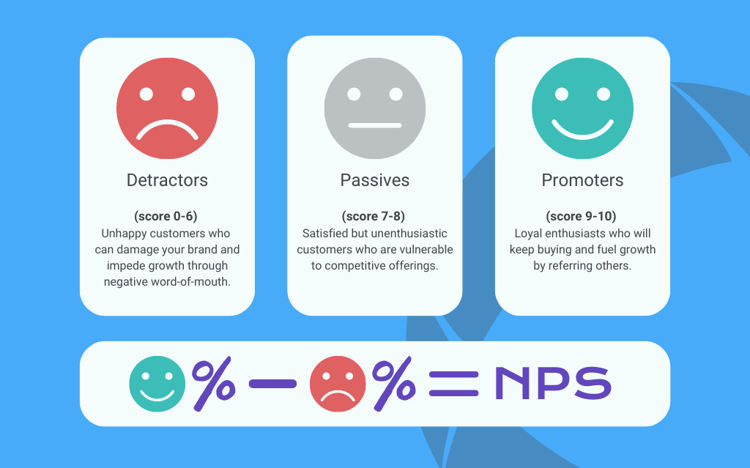The Net Promoter Score is famously known as "The One Number You Need to Grow" and finds it origin in 2003. In today's business world, the Net Promoter Score (NPS) is an essential key performance indicator in any boardroom meeting.
However, the Customer Effort Score (CES) is gaining increasing recognition. CES is a relatively new metric that also explores the connection between customer satisfaction and loyalty. Both metrics have their advantages and disadvantages.
When is the ideal time to utilise each metric? Is it necessary to make a choice between them?
The Net Promoter Score – NPS
The Net Promotor Score is based on the idea that an organisation can divide its customers into three categories: promoters, passives and detractors. The customers can be categorised by asking one simple question:
“How likely is it that you would recommend [organisation X] to a friend or colleague?”
-
Promoters: the customers who answered the question with a 9 or 10.
-
Passives: the customers who answered the question with a 7 or 8.
-
Detractors: the customers who answered the question with a 6 or lower.
The Net Promoter Score is the percentage of promoters minus the percentage of detractors. Note that the NPS can also be negative.

The main critique of the NPS is that it does not measure the actual customer behaviour: customers make a prediction about their future behaviour when answering the NPS question. However, scientific research has shown that customers find it easier to assess a recent and real experience. In addition, critics argue that it is not only important to measure the likeliness of recommendation to others, but mainly the customer’s eagerness to continue to do business himself or to even enlarge his commitment. Unfortunately, the NPS does not offer this perspective.
So why does one use this metric so much? The great strength of this metric lies in its simplicity. With just one simple question, two key points are measured: customer loyalty and future financial growth.
Promotors will after all remain the customers of your organisation, while there is also accretion of new clients. Also, each employee within your organisation will understand the NPS after a brief explanation. Hence, the popularity of the model makes it easier for marketers to use the metric and benchmark results.
The Customer Effort Score – CES
The Customer Effort Score is based on the finding that customers ‘punish’ an organisation easier than reward them. News about a bad service experience usually reaches twice as many people as a good service experience. For this reason, reducing customer dissatisfaction yields sometimes more than increasing customer satisfaction.
The Customer Effort Score charts how much effort a customer needs to put in during his or her customer journey. Elements such as time, money and risk are understood as effort. When measuring the CES, the focus is on a specific process of service, and the customer is asked to review this process by the criterion of difficulty/ease. It is necessary that the customer has been in contact with the specific point in the process that is being measured. The amount of effort experienced by the customer is measured by prompting the question:
“How much effort did you personally have to put forth to handle your request?”
The customer can answer this question on a five-point Likert scale, with the lowest score standing for very little effort and the highest score for a lot of trouble. A low score implies that the process took the customer little effort. The chance that this customer will turn to the competitor is therefore low – why change when the service runs smoothly?
.png?width=1000&height=450&name=Five-point%20likert%20scale%20(2).png)
Organisations can create loyal customers by solving problems quickly and easily. The swift handling of complaints can provide a strong sense of loyalty to the customer. This way, one bends a negative experience into a positive experience.
CES correlates well with customer behaviour because of the complexity and multitude of products and services. In addition, the fact that a customer sometimes even gets different answers from customer service depending on whom one speaks causes frustration. Fix the basics first.
But ease is not everything. Compared to a fancy restaurant, it is easier to make a choice from the menu of a fast-food chain and to place an order, it is easier to eat (you do not even need cutlery) and the whole process takes just a minimum of time. Yet there are people who prefer to eat at a fancy restaurant instead of a fast-food place, even for a multiple of the price. Ease is only one dimension of the complex interaction between a customer and an organisation.
Practical examples of NPS and CES
Imagine you are an energy supplier. Your main task is to make sure that your customers can purchase energy from you without problems. If this goes well, your customers will not shout it from the rooftops.
Nowadays we find it quite normal that the light is on. Your service only stands out as soon as the light is off. At that moment, you can make a difference by solving the problem as quickly as possible, so the light is back on without too much difficulty for the customer.
How well you handle this situation, is measured with the Customer Effort Score. Therefore, it is important that your customer actually had to deal with a power outage and with your service at that time.
But what if you are an accountant? First and foremost, customers come to you to check their figures or to put their administration into your hands. If your organisation performs well on these tasks, your customers will be satisfied but it will not be striking.
If you think as an accountant along with your customer and for example alert him on saving possibilities, you deliver an additional value without the request of your customer. This added value and the exceeding of expectations leads to more satisfied customers who are delighted to share their good experiences.
This recommendation intention can be measured by the Net Promoter Score. However, it is never certain whether customers will convert this intention into actual behaviour.
Which metric is best?
Both metrics have their pros and cons. NPS measures the entire relationship between the customer and the organisation and makes a prediction of the customer’s future behaviour. A customer can recommend an organisation but it is never guaranteed that the customer remains a customer.
The NPS score is affected by customer service but also by quality, price and brand. If an organisation solely focuses on NPS, one will not be able to determine which customer service improvements will have the greatest impact on loyalty.
From that point of view, the CES may be of interest. This metric only focuses on the ease of handling customer problems.
So in this case, it is essential that the customer has been in contact with the questioned process. CES provides more useful insights to address the obstacles that appear during the service experience. NPS and CES provide answers to various questions but are strongly interrelated.
Which question an organisation will focalise, depends on the specific aim of the organisation. To that end, earlier practices can be an inspiration.






/Mini-guide%20Employee%20Experience/MiniGuide_EmployeeExperience_uitgelicht.png?width=410&height=220&name=MiniGuide_EmployeeExperience_uitgelicht.png)


.png?width=410&height=220&name=employer-experience-zorg-sector-unie-k%20(1).png)